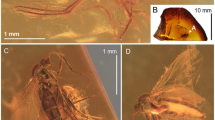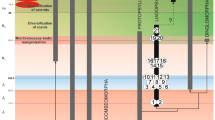Abstract
THE termite genus Anoplotermes Müller1 is, along with Speculitermes Wasmann2, unique among termites in not having a soldier caste, only the workers and the reproductives being present. The two genera have a close resemblance to each other. Speculitermes has been regarded by certain authorities, for example, Holmgren3 and Grassé4, as a subgenus of Anoplotermes, while others5 regard it as a full genus. We believe the latter view to be more tenable since the differences between the two genera are considerable, though they are undoubtedly closely allied. They may be keyed as follows: 1 (2). Smaller forms (head-width c. 0.4–1.2 mm.). Mid-dorsal spot on head either absent or greatly reduced. Antennae shorter (1.2–1.6 times the head-width); with 14 segments; 3rd segment smaller than 2nd. Foretibia swollen. Tibial spur formula variable, either 3 : 2: 2 or 2:2:2. Left mandible with an apical and 2 or 3 marginal teeth, the 3rd marginal, when present, very small. .... Anoplotermes 2 (1). Larger forms (head-width c. 1.0–1.4 mm.). Mid-dorsal spot on head (‘Stirnocellus’ of Wasmann) large and prominent. Antennae longer (1.5–2.0 times the head-width); with 14–15 segments; 3rd segment longer than second. Foretibia not swollen. Tibial spur formula 2:2:2. Left mandible with an apical and 2 marginal teet ........ Speculitermes
This is a preview of subscription content, access via your institution
Access options
Subscribe to this journal
Receive 51 print issues and online access
$199.00 per year
only $3.90 per issue
Buy this article
- Purchase on Springer Link
- Instant access to full article PDF
Prices may be subject to local taxes which are calculated during checkout
Similar content being viewed by others
References
Müller, F., Jena Z. Med. Naturwiss., 7 (3), 347 (1873).
Wassmann, E., Zool. Jb. (Syst.), 17 (1), 161 (1902).
Holmgren, N., K. Sv. Vet. Akad. Handl., 48 (4), 74 (1912).
Grassé, P.-P., “Traité d. Zool.”, Paris, 9, 408 (1949).
Snyder, T. E., Smithson. Misc. Coll., 112, 103 (1949).
Silverstri, F., Redia, 1, 100 (1903); Boll. Lab. Zool. gen. agrar. Portici, 9, 51 (1914).
Emerson, A. E., Zoologica, 6, 423 (1925).
Sjöstedt, Y., K. Sv. Vet. Akad. Handl., (3) 3 (1)., 289 (1925).
Roonwal, M. L., and Sen-Sarma, P. K., “Contributions to the Systematics of Oriental Termites”, Ent. Monogr. 1, Indian Counc. Agric. Res., New Delhi (in the press).
Wegener, A., “Die Entstehung der Kontinente und der Ozeane”, 3rd ed. (Braunschweig, 1922).
Author information
Authors and Affiliations
Rights and permissions
About this article
Cite this article
ROONWAL, M., CHHOTANI, O. New Neotropical Element (Anoplotermes) in Indian Termite Fauna. Nature 184, 1967–1968 (1959). https://doi.org/10.1038/1841967b0
Issue Date:
DOI: https://doi.org/10.1038/1841967b0
Comments
By submitting a comment you agree to abide by our Terms and Community Guidelines. If you find something abusive or that does not comply with our terms or guidelines please flag it as inappropriate.



